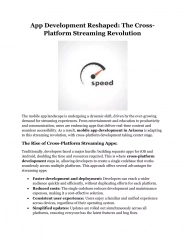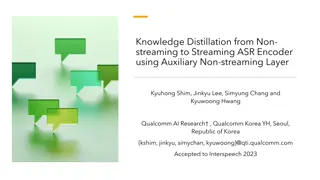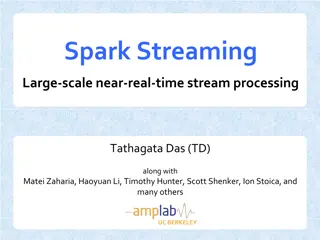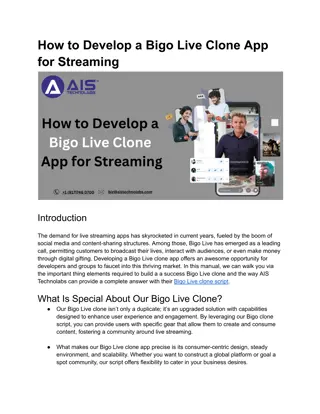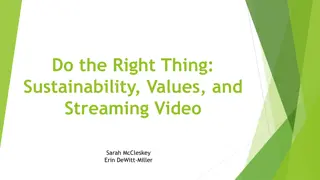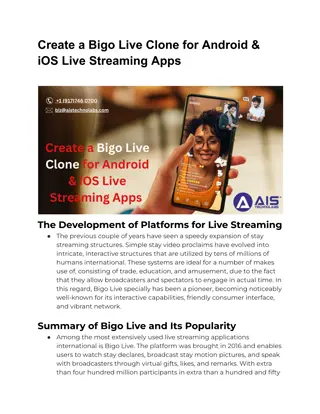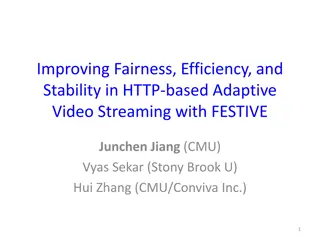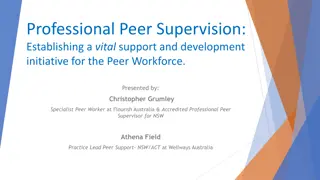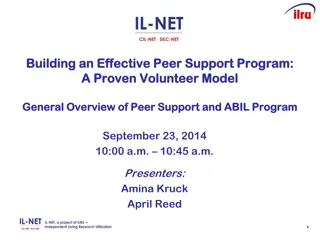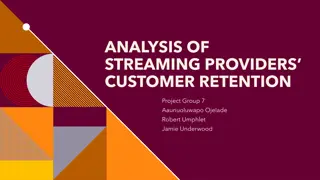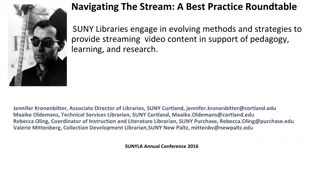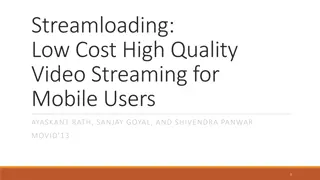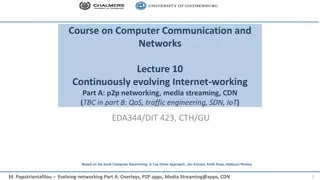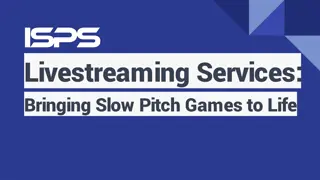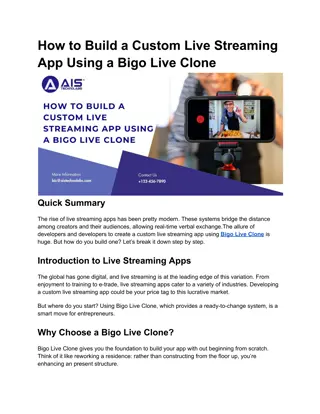Peer-to-Peer Streaming Overview
Peer-to-Peer Streaming in a comprehensive manner covering topics such as distribution topologies, system properties, and issues faced. Learn about push-based and pull-based distribution approaches, as well as the pros and cons of P2P systems. Discover the challenges and benefits of relying on end hosts for packet forwarding in this detailed study by NUS.SOC.CS5248-2017."
Download Presentation

Please find below an Image/Link to download the presentation.
The content on the website is provided AS IS for your information and personal use only. It may not be sold, licensed, or shared on other websites without obtaining consent from the author.If you encounter any issues during the download, it is possible that the publisher has removed the file from their server.
You are allowed to download the files provided on this website for personal or commercial use, subject to the condition that they are used lawfully. All files are the property of their respective owners.
The content on the website is provided AS IS for your information and personal use only. It may not be sold, licensed, or shared on other websites without obtaining consent from the author.
E N D
Presentation Transcript
Peer-to-Peer Streaming NUS.SOC.CS5248-2017 Roger Zimmermann (based in part on slides by Ooi Wei Tsang)
Peer-to-Peer Streaming A type of application-level multicast But packets are forwarded by end- host (not proxies) NUS.SOC.CS5248-2017 Roger Zimmermann (based in part on slides by Ooi Wei Tsang)
Peer-to-Peer Streaming ALM with end-hosts as forwarders End Host Video Server Overlay Links S NUS.SOC.CS5248-2017 Roger Zimmermann (based in part on slides by Ooi Wei Tsang)
Issues with P2P Streaming Depends on peers to forward packets, but peers can fail/leave anytime S NUS.SOC.CS5248-2017 Roger Zimmermann (based in part on slides by Ooi Wei Tsang)
Distribution Topologies (1) Push Based: Distribution tree or DAG Data is pushed from the source through the tree End Host Video Server Overlay Links S Low latency; good for live streaming NUS.SOC.CS5248-2017 Roger Zimmermann (based in part on slides by Ooi Wei Tsang)
Distribution Topologies (2) Pull Based: Mesh; data is pulled from a number of known neighbors. Each node keeps a segment map. R High robustness; but longer latency NUS.SOC.CS5248-2017 Roger Zimmermann (based in part on slides by Ooi Wei Tsang)
Distribution Topologies (3) Pull Based: Examples (no longer existent): PPTV, original P2P version was created by Huazhong University of Science and Technology CoolStreaming, similar to BitTorrent, data driven overlay network There has been some interest to use set-top boxes (STB) for P2P support NUS.SOC.CS5248-2017 Roger Zimmermann (based in part on slides by Ooi Wei Tsang)
Properties of P2P Systems Pros Inherently scalable since each new user brings resources to the system (i.e., bandwidth) self-scaling Cons Nodes are unreliable disruptions! Nodes need to contribute on average as much as they use Free-riders/cheaters Monitoring of the system state NUS.SOC.CS5248-2017 Roger Zimmermann (based in part on slides by Ooi Wei Tsang)
CoopNet Resilient Peer-to-Peer Streaming, V. Padmanabhan et. al. ICNP 2003 NUS.SOC.CS5248-2017 Roger Zimmermann (based in part on slides by Ooi Wei Tsang)
Idea To increase robustness: Split video into k parts , send one part along one tree. NUS.SOC.CS5248-2017 Roger Zimmermann (based in part on slides by Ooi Wei Tsang)
Smart Splitting A node may be able to reconstruct partial data with a subset of the parts. More parts better quality. Multiple Description Coding NUS.SOC.CS5248-2017 Roger Zimmermann (based in part on slides by Ooi Wei Tsang)
Simple Example (Video) Divide into two descriptions 1. Even frames 2. Odd frames Multiple State Encoding Does not scale to a large number of descriptions. NUS.SOC.CS5248-2017 Roger Zimmermann (based in part on slides by Ooi Wei Tsang)
Layered Coding Layer 1 Layer 2 Layer 3 NUS.SOC.CS5248-2017 Roger Zimmermann (based in part on slides by Ooi Wei Tsang)
Layered Coding One layer one description? But there are dependencies between the descriptions. NUS.SOC.CS5248-2017 Roger Zimmermann (based in part on slides by Ooi Wei Tsang)
Multiple Description Coding D1 L1 L2.1 L3.1 D2 L1 L2.2 L3.2 L2.1 XOR L2.2 L1 L3.3 D3 NUS.SOC.CS5248-2017 Roger Zimmermann (based in part on slides by Ooi Wei Tsang)
Multiple Description Coding D1 L1 L2.1 L2.2 L2.3 L3.1 D2 L1 L2.3 L2.4 L2.1 L3.2 D3 L1 L2.1 L2.2 L2.4 L3.3 D4 L1 L2.3 L2.4 L2.2 XOR NUS.SOC.CS5248-2017 Roger Zimmermann (based in part on slides by Ooi Wei Tsang)
How to Build Tree? Send one description along one tree only. A node is internal node in at most one tree, and is leaf node in the rest of the trees. NUS.SOC.CS5248-2017 Roger Zimmermann (based in part on slides by Ooi Wei Tsang)
Example R R 3 4 1 2 2 4 5 6 1 3 5 6 NUS.SOC.CS5248-2017 Roger Zimmermann (based in part on slides by Ooi Wei Tsang)
Tree Maintenance The source of video maintains all states. Isn t this a centralized design that is not robust? NUS.SOC.CS5248-2017 Roger Zimmermann (based in part on slides by Ooi Wei Tsang)
Node Join Becomes internal node in a tree with least number of internal nodes. Becomes leaf node in the rest of the trees. NUS.SOC.CS5248-2017 Roger Zimmermann (based in part on slides by Ooi Wei Tsang)
To join as internal node Pick highest internal node with enough bandwidth as parent. If cannot find, pick internal node with leaf node as child, preempt the leaf node. NUS.SOC.CS5248-2017 Roger Zimmermann (based in part on slides by Ooi Wei Tsang)
To join as leaf node Pick highest internal node with enough bandwidth as parent. If cannot find, migrate an internal node from another tree. NUS.SOC.CS5248-2017 Roger Zimmermann (based in part on slides by Ooi Wei Tsang)
Network Efficiency When choosing parents, breaks ties by choosing closer node as parents. NUS.SOC.CS5248-2017 Roger Zimmermann (based in part on slides by Ooi Wei Tsang)
Effects of Number of Trees NUS.SOC.CS5248-2017 Roger Zimmermann (based in part on slides by Ooi Wei Tsang)
Effects of Number of Trees NUS.SOC.CS5248-2017 Roger Zimmermann (based in part on slides by Ooi Wei Tsang)
MDC versus FEC NUS.SOC.CS5248-2017 Roger Zimmermann (based in part on slides by Ooi Wei Tsang)
Summary of CoopNet Robustness through redundancy in coding network paths NUS.SOC.CS5248-2017 Roger Zimmermann (based in part on slides by Ooi Wei Tsang)
Issues with P2P Streaming Not all peers are happy to contribute resources selfish peers exist. S NUS.SOC.CS5248-2017 Roger Zimmermann (based in part on slides by Ooi Wei Tsang)
Deter Selfish Peers Add a constraint: A peer can only receive at most as much as it is willing to send S/R 1 NUS.SOC.CS5248-2017 Roger Zimmermann (based in part on slides by Ooi Wei Tsang)
Practical Issues Asymmetric Links Different downlink capacity NUS.SOC.CS5248-2017 Roger Zimmermann (based in part on slides by Ooi Wei Tsang)
Dagster Contributor Aware P2P Streaming in Heterogeneous Environment MMCN 2005 NUS.SOC.CS5248-2017 Roger Zimmermann (based in part on slides by Ooi Wei Tsang)
Goals Robustness wrt transient peers Deter selfish users without restricting S:R ratio Heterogeneous receivers NUS.SOC.CS5248-2017 Roger Zimmermann (based in part on slides by Ooi Wei Tsang)
Issue 1 Heterogeneous receivers Solution: Transcoding NUS.SOC.CS5248-2017 Roger Zimmermann (based in part on slides by Ooi Wei Tsang)
Transcoding D A C E S F B NUS.SOC.CS5248-2017 Roger Zimmermann (based in part on slides by Ooi Wei Tsang)
Issue 2 Improve Robustness Solution: Distributed Streaming NUS.SOC.CS5248-2017 Roger Zimmermann (based in part on slides by Ooi Wei Tsang)
Distributed Streaming D A C E S F B NUS.SOC.CS5248-2017 Roger Zimmermann (based in part on slides by Ooi Wei Tsang)
Multiple State Encoding D 1,3,5.. A C E S F B NUS.SOC.CS5248-2017 Roger Zimmermann (based in part on slides by Ooi Wei Tsang)
Issue 3 Provide incentives without constraining S:R ratio? Solution: give peers that pledge more contributions some benefits contributor-aware NUS.SOC.CS5248-2017 Roger Zimmermann (based in part on slides by Ooi Wei Tsang)
Providing Incentives Idea: allow a peer to preempt another peer with smaller contributions Benefits Lower rejection rate Closer to source NUS.SOC.CS5248-2017 Roger Zimmermann (based in part on slides by Ooi Wei Tsang)
DAG Construction NUS.SOC.CS5248-2017 Roger Zimmermann (based in part on slides by Ooi Wei Tsang)
Example 15:5 A 0:30 S 15:5 B NUS.SOC.CS5248-2017 Roger Zimmermann (based in part on slides by Ooi Wei Tsang)
Example 15:5 A 0:30 S 15:5 B NUS.SOC.CS5248-2017 Roger Zimmermann (based in part on slides by Ooi Wei Tsang)
Example 15:5 A 0:30 S 15:15 15:5 B C NUS.SOC.CS5248-2017 Roger Zimmermann (based in part on slides by Ooi Wei Tsang)
Example: Preemption 15:5 A 0:30 S 15:15 15:5 C B NUS.SOC.CS5248-2017 Roger Zimmermann (based in part on slides by Ooi Wei Tsang)
Example: Rejection 15:5 A 0:30 S 15:5 15:6 B D NUS.SOC.CS5248-2017 Roger Zimmermann (based in part on slides by Ooi Wei Tsang)
Preemption Rules A can preempt B if A is willing to donate more than B B can find new parents after preemption NUS.SOC.CS5248-2017 Roger Zimmermann (based in part on slides by Ooi Wei Tsang)
Example 15:5 A 0:30 S 10:5 15:5 B E NUS.SOC.CS5248-2017 Roger Zimmermann (based in part on slides by Ooi Wei Tsang)
Example 15:5 A 0:30 10:5 S E 15:5 B NUS.SOC.CS5248-2017 Roger Zimmermann (based in part on slides by Ooi Wei Tsang)
Example 15:5 2:1 A F 0:30 S 10:5 15:5 2:1 B H G NUS.SOC.CS5248-2017 Roger Zimmermann (based in part on slides by Ooi Wei Tsang)
Example: 2 Preemptions 15:5 2:1 A F 0:30 10:5 S G 15:5 2:1 B H NUS.SOC.CS5248-2017 Roger Zimmermann (based in part on slides by Ooi Wei Tsang)
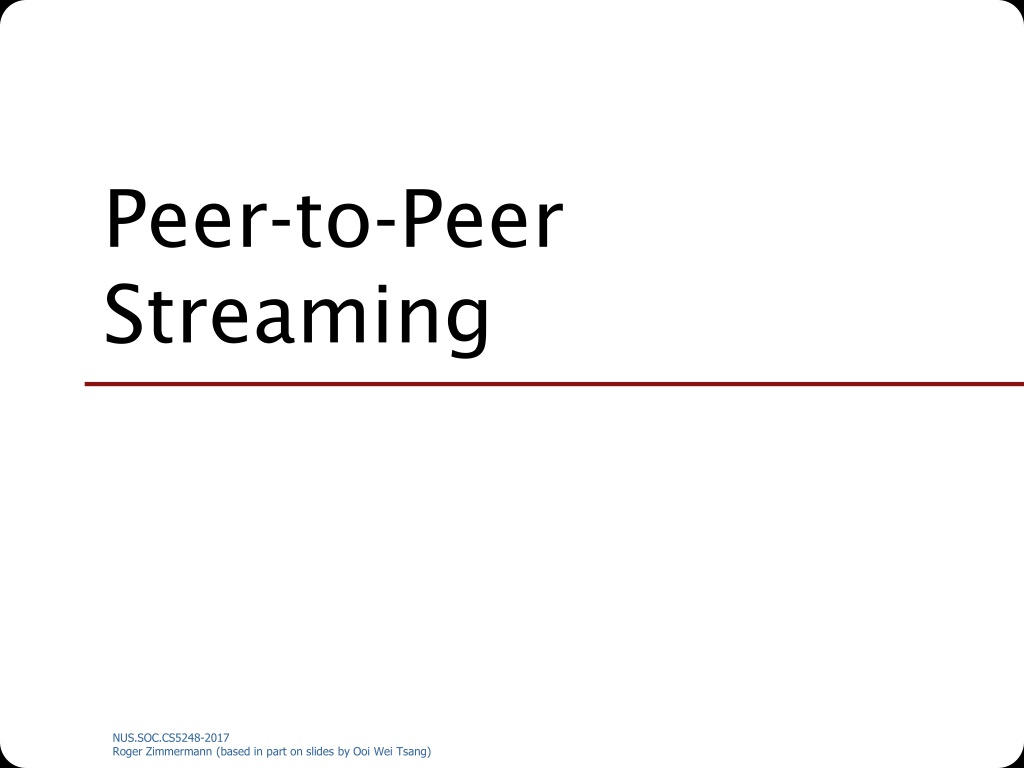
 undefined
undefined
